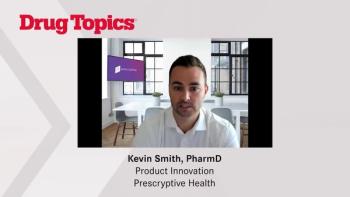
- Drug Topics January 2019
- Volume 163
- Issue 1
How Blockchain Can Reduce Waste, Fraud in Pharmacy
The emergent technology is adding security and accountability to distributions, and will likely connect manufacturers and distributers in the near future.
Blockchain technology is creating more ways for healthcare to increase safety and efficiency by decentralizing data. Nearly half of healthcare companies report that they are developing blockchain solutions, according to a 2018 global blockchain survey by PricewaterhouseCoopers Health Research Institute.
Blockchain is defined as an open record of transactions, or a ledger, that can be managed by and distributed to several stakeholders instead of being maintained in one location. The stakeholders are a part of a network that can add data to the ledger, and transactions can be vetted by the network. As the network verifies and accepts transactions, a block of data is created. Several transactions are linked in a chain, with each block building upon the data of a previous block.
Because the integrity of the data is distributed across several blocks, data tampering is more difficult, and transactions are easier to trace. In healthcare, this allows for several stakeholders from different silos, including providers, payers and pharmacies, to have access to data.
As the industry grapples with increased fraud and waste as opioid abuse continues to rise, blockchain technology can add more security and accountability to the distribution process, says Carly Guenther, managing director of life sciences supply chain for Accenture.
“Many controlled substances are still prescribed using paper prescriptions, which will only be identified during the dispense/claim adjudication transaction phase,” Guenther says. “With blockchain, we could create a secure distributed ledger that allows witness identification to be recorded at the appropriate times.” Blockchain enables real-time access for authorized individuals to view controlled drugs transactions. Stakeholders could include law enforcement, researchers, clinicians, and payers, she adds. Accenture estimates roughly 30% of business costs are locked up in point-to-point messaging, she says.
“Once blockchain is fully adopted across the supply chain, we will be able to fully optimize the supply chain network and ecosystem, which will create a significant value internally and externally to all organizations,” Guenther says. “From the manufacturer to the patient, the flow of goods and information will enable even new business models and help drive a more patient-focused supply chain.”
Connecting Silos
Though the benefits of blockchain in pharmacy are numerous, the industry has to overcome hurdles before the technology can be deployed to its fullest potential, says Darryl Glover, PharmD, MBA, chief clinical officer at Gerson Lehrman Group.
“The main silo is that the members of the supply chain, manufacturers, wholesalers and inpatient/outpatient pharmacies, have not historically worked constructively together and have a lack of trust in each other’s motives,” Glover says. “It is exactly this lack of trust that makes blockchain powerful. It can serve as a bridge to interconnect these parties and allow them to share information more readily as trust develops.”
Glover says deploying blockchain in a pharmaceutical supply chain requires stakeholder to have interoperable communication. “Blockchain serves as a bridge between and within the individual organizations to connect their systems together that do not readily communicate with each other. The data would definitely be more secure, and the network could be extended to include patients,” Glover says. “In this way, all of the members of the supply chain would be involved, and this then opens up possibilities for gaining access to data that was not previously possible.”
Using blockchain in the supply chain can also reduce the risk of fraudulent drugs infiltrating the supply chain. “Counterfeit pharmaceuticals are now considered to be the world’s largest fraud market. Blockchain technology could provide an answer,” Guenther says. “Packages have labels that are scanned at every point along its journey from factory to pharmacy. These labels would connect to a blockchain system.”
Blockchain Solutions in Action
A collaborative effort between Lipscomb University and a nonprofit pharmacy in Tennessee will use blockchain technology to provide drugs to customers who are underinsured. In November 2018, the university announced a collaboration using technology created by RemediChain that allows patients to donate their unused oral chemotherapy drugs to patients with financial difficulties.
Using blockchain, RemediChain is growing its network of prescription drugs that can be redistributed in an effort to eliminate waste in the industry. The company accepts prescription donations from patients across the country. When a donation is accepted, it receives a date, time, and location “stamp,” and is entered into the blockchain system. That medication is then tracked along every point in the chain of custody until it is either taken by a patient or properly destroyed.
RemediChain is already being used in a statewide, nonprofit pharmacy in Iowa, and Philip Baker, PharmD, CEO of RemediChain, says they plan to deploy the technology across nonprofit pharmacies across the country.
“RemediChain will allow us to tap into the vast amount of unused medicine that lies in the hands of patients and distribute those medications to our network of charity pharmacies all over the country,” Baker says.
The Future of Blockchain
In the next five years, more blockchain solutions connecting manufacturers and distributors to track chain of custody will be common place, Baker says.
“In 10 years, we’ll see pharmacies that run on their own cryptocurrency (or token), eliminating the need for pharmacy benefit managers and third-party payers,” Baker says.
However, Guenther says because specialty pharmacies and independent pharmacies are small, they probably will be the last dispensers to link up to any blockchain ledger because of the complexity and expense.
“Lack of specialty pharmacy participation will be a hurdle to success because last-mile delivery of the therapy to the patient is critical, and the cost of specialty drugs are material to payers,” Guenther says.
But even small and independent pharmacies can see the benefits are deploying blockchain in the immediate future, Glover says.
“Blockchain is the right tool if there is a need to create an interoperable network between systems that do not readily connect to each other or there is a need for business or regulatory reasons to have true data provenance,” Glover says. “The only investments that need to be made are in connecting the systems to the blockchain and creating a user interface. Blockchain technology itself is free to use and some time would need to be invested to create a private blockchain, or it could be outsourced.”
Up Next: Where to start with Blockchain.. Where to Start
Carly Guenther, managing director of life sciences supply chain for Accenture, says pharmacies should consider three things before planning to invest in blockchain technology:
- Identify the Use Case
- Start with the business challenges that need to be addressed. There are plenty of use cases that do not make sense for blockchain, so nailing down the priority use cases that are relevant for blockchain is a critical first step.
- Plan and Design for Proof of Concept
- This allows for experience to be gained on the power of the technology, appreciation of what is required for broader scale success, and the ecosystem/partners that need to participate.
- Stay Grounded on the Business Value
- Investments in proof of concepts are generally fairly light, but they provide significant value in learning how to take an organization’s utilization of blockchain to the next level.
Donna Marbury is a healthcare, technology, and business journalist based in Columbus, OH.
Articles in this issue
almost 7 years ago
A Pharmacist's New Year's Resolutionsalmost 7 years ago
Duvelisib for Relapsed or Refractory CLL/SLLalmost 7 years ago
Opinion: A New Toolkit to Fight Opioid Abusealmost 7 years ago
10 Pharmacists to Follow on Twitteralmost 7 years ago
Small Doses: January Newsalmost 7 years ago
The 10 Most Exciting Drugs in the 2019 Pipelinealmost 7 years ago
Pharmacist-Driven Intervention Program Reduces Readmissionsalmost 7 years ago
Chronic Kidney Disease Patients Need Advice On Diet, Drug Buildupalmost 7 years ago
Independent Pharmacies: Not Dead Yetalmost 7 years ago
5 New Pharmacy Rules and Regulations to WatchNewsletter
Pharmacy practice is always changing. Stay ahead of the curve with the Drug Topics newsletter and get the latest drug information, industry trends, and patient care tips.





























































































































